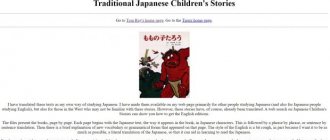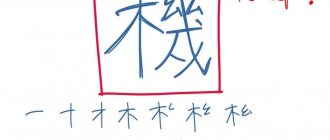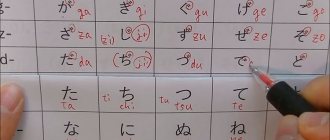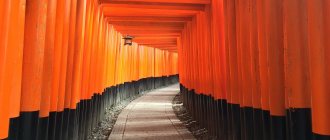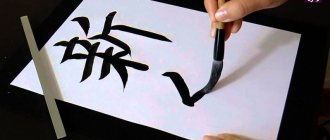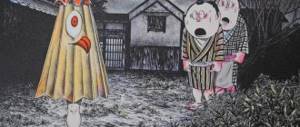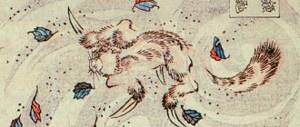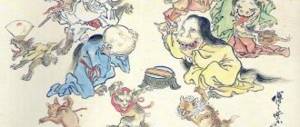The Japanese language has three writing systems. Two syllabary alphabet - hiragana and katakana - are used simultaneously with hieroglyphs, or kanji, which came to Japan from China. Let's figure out how hiragana and katakana sound in Russian, how they differ, look at tables with katakana and find out how best to learn it.
Katakana
see also: Hiragana | Kiriji and Romaji
Katakana is a syllabary (each character means a syllable, not a sound) used in the Japanese language.
It is part of the modern Japanese language. It includes 46 characters (and a few obsolete ones). Katakana is mainly used to write borrowed words and interjections. Borrowed words mean all foreign words, names and titles. Once you learn katakana, you will be able to read most store signs, restaurant menus, character names, Internet pages, and Japanese CDs. In fact, in most cases, English words are written in katakana, that is, it turns out something like writing Russian words in transliteration (vi ponimaete, chto ya imeu v vidy ^_^), and therefore, with sufficient knowledge of the English language, you will understand what is being said . In katakana, each character (with the exception of vowels and one exception) does not represent a letter, but a syllable - that is, a combination of a consonant and a vowel. There are simply no symbols for consonants in katakana. Each syllable has its own pronunciation, which never changes, regardless of the position of the syllable in the word or adjacent syllables, which is very convenient for memorization. True, there are compound sounds consisting of several syllables, but they are also always pronounced the same way. The entire set of sounds is based on “soft” consonants (t, k, s, x). Their “hard” analogues are obtained by adding two dashes to the original ( nigori
) in the upper right corner of the icon. (If you don’t understand, don’t be alarmed, you’ll figure it out as you go). Now that the structure of the language (katakana) has become a little clearer, let's move on to practical examples. I will write the Japanese spelling of the syllable, the official spelling of the syllable (in romaji), in brackets - an alternative version, if there is one (in the Hepburn system), and through a slash - the Russian transcription (in the Polivanov system).
How to learn hiragana and katakana
There are many ways to remember all these Japanese characters. To get started, you can print out the hiragana and katakana alphabet in a table and hang it in a visible place on your desktop. Being always before your eyes, the letters will automatically be remembered.
Hiragana and katakana: table in Russian.
Even though people write by hand less and less these days, you will need to use cursive writing . When writing syllables, muscle memory is activated and they are remembered faster.
We must remember that the order in which the strokes are written is very important. It greatly simplifies life, because the writing skill becomes automatic, which helps with memorization.
You can start with copybooks for beginners. They do not have voiced or compound syllables, but if you remember the spelling of the basic combinations, you will not have any difficulties with the rest. Then you can move on to more complex katakana writing.
Although katakana is easier to write, it is quickly forgotten. To avoid this, it is recommended to practice writing these two alphabets in parallel. This will help you avoid confusion between them in the future. Practice sheets can be found below.
Hiragana and katakana - copybooks:
- Hiragana alphabet;
- katakana alphabet.
And if you have not yet learned enough about the rules of writing hiragana, we recommend that you read our article on Japanese writing. In it you will also find hiragana and katakana copybooks, which can be downloaded in PDF format.
Another way to learn a language is through mnemonics . If you just try to memorize a word, you will forget it in a few days. Therefore, it is better to use special associative techniques to remember new words or symbols. All three writing systems—kanji, katakana, and hiragana—are best taught using this method.
You can also use cards : write the letter on one side and the translation on the other. But no more cutting them out of cardboard, because Quizlet lets you create them online. There you will also find already created training materials. For example, mnemonic cards for hiragana and katakana for beginners.
Katakana: learn with mnemonics.
Another fun way to learn these ABCs is to learn a nursery rhyme. They are very presentable, so you still have to try to forget her.
Now you know what the Japanese katakana alphabet sounds like with a translation into Russian and where it is used. Katakana is no less important aspect of the language than its sister alphabet. With its help, the text places emphasis on individual words, giving them a special shade.
What do you like best: Japanese katakana and hiragana or kanji? Write in the comments!
Japanese katakana alphabet: table, pronunciation and writing. The most important thing you need to know about katakana! Learn katakana tables in Russian and methods of memorizing them.
Consonant group "H-B-P"
= ha / ha = hi / hi = hu (fu) / hu - the Japanese do not distinguish between “hu” and “fu” = he / he = ho / ho
= ba / ba - sometimes used as “va” = bi / bi = bu / bu = be / be = bo / bo
= pa / pa = pi / pi = pu / pu = pe / pe = po / po
As you can see, the Japanese liked the letter “x” so much that they decided to form not one, but two “hard” sounds from it! ^_^ The sound “b” is marked with the usual dashes, and “p” - with a circle ( hannigori
).
Special sign
= does not have its own pronunciation
In Japanese, there is a special symbol that denotes the doubling of the initial consonant of the following syllable. You noticed that it looks like a reduced katakana “tu / tsu”, but does not have its own pronunciation (like our soft or hard sign). Its goal is to emphasize the pronunciation of the initial consonant in any syllable. In fact, its presence in a word shows that the initial consonant of the following syllable must be pronounced twice, that is, for example, the syllable “that” will turn into “t-that”. As part of a word it will look like: “lo-to” => “lo-t-to”. Agree, the second option sounds much better and is more similar in pronunciation to the Russian version. Here's an example:
Congratulations! You have finished learning katakana! This was the last symbol. True, there are still a few subtleties left, which I will discuss below.
Examples of spelling words
Now that (if) you have memorized the spelling and pronunciation of all the characters, I will give some examples of writing simple words. Of course, there are some nuances that I haven’t explained, but I’ll do that later.
It's exactly the same with English words. Oh, by the way, if you are wondering why I wrote the syllables “ru” and “ra” in katakana, but translated them as “lu” and “la,” then read on. If you haven’t noticed this, then you should re-read the above text again and figure out the spelling of the syllables.
Pronunciation of “long” vowels
When the Japanese feel that a certain syllable or vowel is being pronounced unforgivably long, that is, longer than its “classical” pronunciation, they mark this in katakana notation by placing a long horizontal line (like our dash) after the syllable or vowel. In fact, figuring out when a sound lasts long enough to mark it with a line is extremely difficult (I never succeed), so this moment is only important for reading the text. It is almost impossible to determine for yourself when to draw a line in a recording, since the ideas of Russians, British and Japanese about the longitude of sounds differ greatly. Here is a more or less obvious example, this time, for a change, in English.
Note:
An almost exact sign of a “long” sound is the doubling of the vowel. Almost certainly, instead of a double vowel in katakana writing, you should put a dash - a sign of longitude.
The problem of “identical” sounds. "R - L", "X - F"
The fact is that due to the peculiarities of their language, the Japanese do not distinguish between some sounds that sound the same to them. (Nothing funny! Can you hear the difference in pronunciation between “two”, “too” and “to”?) This feature applies to “b-v”, “ji-ji”, “shi-si”, etc. etc., but most noticeable in the sounds “r-l” and “h-f”. Therefore, to reproduce the sound “l”, a row of the letter “r” is used, and for the sound “f”, a row of the letter “x” is used. However, not everyone was happy with this system, so a new form of writing was adopted, using a combination of several syllables. Now the following spelling is used for the sound “f”:
= fa / fa = fi / fi = fu / fu - aka “hu / hu” = fe / fe = fo / fo
As you can see, the base syllable “hu” is used. We agreed that if we add a vowel to it, it will denote a syllable with the letter “f”. The vowel used to form a new syllable is written in a smaller font size to show this. However, some people are too lazy to reduce something there, so don’t be surprised if you see a vowel of large size (like the syllable itself) added to a syllable - this is in the order of things.
Completely exhausted by such a huge language reform, the Japanese Ministry of Education decided to leave the "r" sound alone, so get used to using the "r" sound instead of "l", it's not that bad, or change your keyboard layout. ^_^
For example, this is what Final Fantasy looks like written in katakana:
Japanese language: katakana alphabet - rules of use
Despite its simple writing, katakana is the more difficult to remember . This is most likely due to its infrequent use. Katakana is the second alphabet, and the first and main alphabet is hiragana. When starting to learn a language, students first encounter it.
The first words and grammatical structures are written and memorized in hiragana, as it is used to indicate the auxiliary parts of words (endings, prepositions, postpositions). Katakana is usually used to write borrowed foreign words , or gairaigo. These include terms that come from Western languages, and borrowed words from Chinese or Korean are written in Kanji. For example:
- ケーキ (ke:ki) from the English “cake” (cake);
- アイスクリーム (aisukri:mu) from the word “ice-cream” (ice cream).
- コンクール (konku:ru) from the French “concours” (competition);
- ノルマ (noruma) from Russian "norm".
The long straight line that you see in the examples serves to indicate the length of the vowel sound.
The names of foreign cities , countries and Western names are exactly the same as gairaigo, so they are written in katakana.
But, in addition to the most common options listed, the Japanese katakana alphabet is found:
- When writing down words whose kanji have practically fallen out of use due to complex spelling. For example, バラ (bara) means “rose” and ゴミ (gomi) means “garbage”. These words also include medical terms . Thus, the disease “cancer” is often denoted by katakana rather than by the hieroglyph 癌.
- When you need to pay attention , focus on a certain word. This technique is often used in advertising, on billboards, road signs or signs. By comparison, in Western languages this is done using italics or bolding.
- When writing technical terms , names of machine , plants , animals , etc.. For example, クモ (kumo) - “spider”.
- In onomatopoeia, or words that convey sound . グーグー (gu:gu) means the sound made when snoring.
- In manga , when you need to emphasize communication in an informal style. For example, you can often see the word “he/she” written in katakana - アイツ (aitsu). This type of writing makes it clear to the reader that the address is most likely made in a disparaging manner.
It is recommended to start learning hieroglyphs last, when both syllabic alphabet are fully mastered. Kanji is an essential element of language, as it is used to write nouns, adjectives and verbs.
This contrast in the use of different writing systems allows you to visually highlight words in the text and recognize which parts of speech they belong to. Because of this, reading speed increases, making comprehension easier.
And to learn more about the two Japanese alphabets, read our article about their differences. It also has katakana and hiragana in tables with Russian transcription and useful tips on how to learn all their signs.
Formation of sounds of the consonant group “B”
You are probably tormented by the question: if there is only katakana “wa”, then how are other syllables with the letter “v”, for example “vo” or “ve” formed? Or do they not exist at all? By the way, in Japanese they really... do not exist (or rather, they do not differ from the sound “b”), but they are still present to write foreign words (as is the case with the sound “f”). There is no single system of syllable formation, but the almost official version looks like this:
= wa / wa = wi / vi = wu / wu - aka “u / y” = we / ve = wo / in
Note:
sometimes you can find an old spelling of these syllables that is not used in modern speech, which I will now give as information for your information so that you are not surprised if you come across this somewhere in the text.
= wi / vi - not used = we / ve - not used = wo / in - not used
I continue to load further, because with the sound “v” the situation is far from simple, since in English the two sounds “v” are “w” and “v”, which differ from each other, therefore in katakana there is also a notation for the sounds of the group "v". These syllables are also based on the vowel "u", but nigori is added to them, since the sound "v" is harder. Next, a formative vowel (small in size) is added, and we get a finished syllable.
= va / va = vi / vi = vu / vu = ve / ve = vo / in
Note:
instead of the syllable “va / wa” the syllable “ba / ba” can be freely used, because in the Japanese language it was not possible to distinguish the difference between them (and there is not).
For Russians, all these syllables with “v” sound almost the same, so the choice of writing form plays a role only when writing English words. Although, in my opinion, it is more competent to use the “w” group to write Russian words, since it is more consistent in pronunciation with the Russian “v”, and Japanese too.
Bottom line: if you understand everything with the letter “v” and its syllables, then you really understand Japanese and English! Although, in fact, everything is not so complicated, because syllables other than “wa / wa” are used extremely rarely by the Japanese. Here you just need to remember that there is a katakana for the sound “wa / wa”, and all other syllables with “v” are built on the basis of “u” by adding the corresponding vowels.
Japanese language: hiragana and katakana
The hiragana and katakana alphabets originated from hieroglyphs at the end of the 13th - beginning of the 9th century. Katakana alphabet
was invented by a Buddhist monk as a form of cursive writing. This was done so that people who do not know Chinese letters could read religious texts.
Its name literally translates to “broken kana” or “divided kanji”, which accurately conveys the story of its origin. After all, katakana characters are entire hieroglyphs in an unmodified form or their individual parts. Review the table below to learn how the Japanese alphabets were formed.
How the alphabet of Hiragana and Katakana was formed: table.
The Hiragana and Katakana alphabet contain a set of characters, each of which represents a different syllable . Despite the fact that both alphabets are phonetically the same, they are not at all similar in writing. Unlike the flowing hiragana with lots of curves and curls, katakana is full of angular letters and straight lines.
Many foreigners have a question: why do the Japanese need two identical-sounding alphabets? However, their main difference is in purpose . Thanks to this, while reading a text, a person can already say a lot about it, even without knowing the translation.
Derivative syllabization
If there are derived vowels, then there must be some derived syllables where these vowels are used. If you think so, then you are absolutely right. The rules for their formation are very simple. Any basic syllable is taken - “consonant_with_sound_” and” “, after this syllable the reduced “ya”, “yu” or “e” is written. We get a new syllable - “consonant_with_derivative_sound”, i.e. when pronounced, the old “i” sound is discarded and a derivative vowel is pronounced instead. I will not give all possible syllables, but you should understand the principle itself. This is what it looks like:
Note:
sometimes the derived vowel is written in the same size as all other syllables. In this case, if it comes after a syllable ending with the sound “i” (the sound, not the katakana “i”!), then we are still dealing with a derived syllable. And if it comes after any other syllable except “consonant + and”, then it sounds on its own.
Let's learn Japanese from scratch! レッスン1 - Lesson 1
© O.N. Kun (lessons 1-3)
Preface
The modern writing system in Japan is perhaps the most complex among all languages in the world. It contains about 2000 hieroglyphs and two alphabets, katakana and hiragana .
At the initial stage of familiarization with the Japanese language, it is advisable to pay attention to the alphabet. Firstly, their writing signs are simpler than hieroglyphs. Secondly, any Japanese word can be written using alphabets.
It is also necessary to become familiar with the systems for transcribing the sounds of Japanese speech, of which there are two: based on the Russian alphabet (used, of course, in Russia) and based on the Latin alphabet (used in Japan, Russia and other countries).
There is another very interesting problem. Why are words that came from Japanese into Russian not always pronounced in accordance with existing rules? The problem is not insignificant. It was in our time, as a result of many achievements of Japan, that a stream of “Japanisms” began to actively penetrate into the Russian language. Names of goods and services, food products, sports terminology. It is not surprising that citizens of our country have questions about the correct spelling and pronunciation of Japanese words. “Toyota” or “Toyota”, “Mitsubishi” or “Mitsubishi”, “sushi”, in the end, or “sushi”?
You will find comments in the corresponding chapter.
Japanese alphabet and its transcription using Russian alphabet characters
The Japanese alphabet is called kana . This is a syllabic alphabet. the katakana and hiragana character systems , as well as two variants of writing in Latin letters: the international Hepburn Latin alphabet and the state Japanese Latin alphabet, which are called romaji . Kana is written in the form of a table of 11 rows, which currently contains 46 main signs (some signs have fallen out of use). In addition, there are 61 syllables, indicated by basic signs with various kinds of icons and indices. These are syllables that are voiced correspondences of basic syllables, and so-called syllables with soft consonants.
Please note that learning new “signs” is different for each person. For some, the tables in this lesson will be enough, for others, they need to be “chewed” and each “sign” presented in a separate lesson + sound + pictures + “cake with tea” and other whims... Therefore, for the second group of people, the message is: nothing is better yet been found. Try to find additional other lessons that would help you learn the alphabet. If you find it, please let me know. Most people learn by “prescribing”, just like we learned Russian letters at school. You can also find many simulators and mobile applications for practicing your ABCs. Lessons 4-7 are given to consolidate the alphabet, you can start with them, consulting with the first three. Any useful advice on improving the first 3 lessons is welcome.
You can start learning Japanese from lesson 4, consulting the first three lessons.
Move your mouse over the sign/letter to see a hint. And don't miss the animated pictures below.
Japanese alphabet in Russian transcription
| A | CA | SA | TA | ON | HA | MA | I | RA | VA | |
| AND | CI | SI | TI | NI | CI | MI | RI | |||
| U | KU | SU | CC | WELL | UGH | MU | YU | RU | ||
| E | CE | SE | TE | NE | HE | ME | RE | |||
| ABOUT | KO | CO | THAT | BUT | XO | MO | Yo | RO | ABOUT | N |
The Russian transcription given is the official (generally accepted) transcription (there are other transcriptions). However , it does not provide an accurate audio representation. In further lessons, read the description of sounds carefully and listen more, only then everything will become clear.
If you see squares below instead of the alphabet, then install the Adobe Kaiti Std R or SimSun font. The archive needs to be unpacked in “Control Panel - Fonts”. Reload the page. It may be worth restarting your computer.
